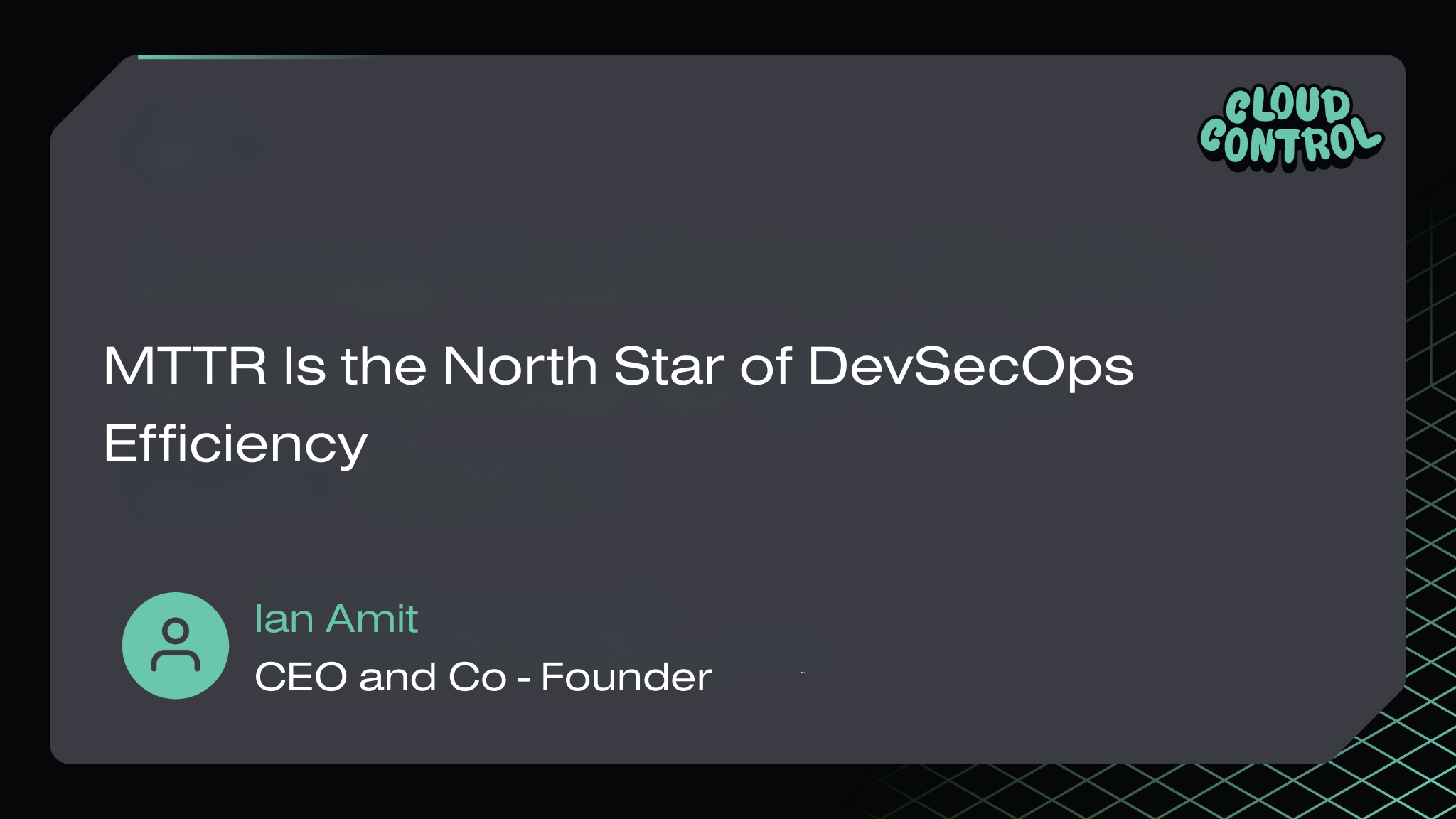
Speed without safety is a false victory. Most teams can detect issues quickly. Too few can fix them fast enough to matter. Mean time to remediate (MTTR) is the signal that cuts through the noise. It shows whether development and security are pulling in the same direction or working at cross-purposes.
As Ian Amit, CEO of Gomboc AI, puts it: “If I can shorten mean time to remediate from weeks to minutes, that’s a huge impact to the business.” That is the aim. Shrink the risk window. Remove the friction. Build a culture where engineering excellence includes security by default.
Why Mean Time to Remediate Is the Metric That Matters Most
MTTR measures how long it takes to move from a confirmed finding to a fix in production. It is the most honest view of risk because it tracks the time an attacker has to take advantage of a known weakness. Faster remediation means less exposure, fewer business interruptions and a smaller blast radius when things go wrong.
It also unites engineering and security under a shared goal. Development leaders care about throughput and stability. Security leaders care about reducing the chance and impact of incidents. DevSecOps metrics often include time to detect and deployment speed, but MTTR bridges both worlds. It converts security intent into shipping discipline. When MTTR trends down, the programme is working. When it stalls, you have a process problem, not just a tooling gap.
The Hidden Costs of Alert Fatigue and Rework
Traditional shift-left efforts often overwhelmed engineers with alert fatigue. The volume moved earlier in the pipeline, but the quality did not change. False positives stayed false. Tickets multiplied. Context scattered across dashboards and queues. Developers learnt to ignore the noise until a release was blocked or a vulnerability turned urgent.
As Amit notes, simply shifting left can feel like “shifting the blame.” Engineers see findings that do not map cleanly to code. Security teams feel accountable for risks they cannot fix. Rework grows. Configuration drift creeps in as hot fixes diverge from infrastructure as code. Every hand-off adds delay. Every context switch pushes MTTR up. If the process punishes people for moving quickly, they will slow down or go around it.
Deterministic AI and the End of Remediation Bottlenecks
Generative tools have a place in modern engineering. They can draft boilerplate, create scaffolding and accelerate documentation. They can also create more to review. More to debug. More to own. Ten times the output can mean ten times the defects if you do not pair speed with precision.
This is where deterministic AI earns its keep. Deterministic systems apply decision logic and knowledge graphs to enforce policies with repeatability. They do not guess. They align code and configuration to standards you define, then present changes that are safe to merge. The result is accuracy you can audit.
Gomboc AI’s approach reflects this reality. Instead of firing off alerts, it generates policy-aligned fixes as pull requests inside GitOps workflows. Engineers stay in their flow. They see what will change and why. They review once, merge once and move on. This removes the remediation bottleneck that lives between detection and done. It also reduces false positives because a proposed fix either compiles against policy and context or it does not.
Designing Teams and Workflows Around MTTR
A metric is only as useful as the behaviour it drives. To make MTTR the operational north star, design the system around faster, safer fixes.
Make MTTR visible. Put it on the same dashboards leaders use for availability and deployment. Report it by service, team and severity. Highlight the longest-running items and the blockers slowing them down. Transparency creates the right pressure.
Treat every pull request as a data point. Capture the time from confirmed finding to approved PR to merged change to production. Automate the timestamping so no one needs to babysit a spreadsheet. When you can see the journey, you can fix the slowest steps.
Eliminate parallel queues. Tickets outside the delivery loop add latency. Put SecOps into the same PR review process your engineers already use. Use standard labels, templates and reviewers. If a fix cannot be proposed as code, ask why. Most security work in cloud and infrastructure as code can be represented as a change you can test, review and ship.
Fit tools to the workflow. Meet engineers where they are. If your tools demand a new console, separate credentials and a different process, expect adoption to lag. If they add a commit or a comment where work already happens, teams will use them.
Align with DORA-style discipline. MTTR sits well beside deployment frequency, lead time for changes and change failure rate. This makes security feel like part of the delivery conversation rather than an audit afterthought. Use the same cadence for reviews, the same rituals for learning and the same ownership model for outcomes.
Automate the obvious. Let policy engines and deterministic systems generate the first draft of a fix. Reserve human judgment for intent and edge cases. The goal is not hands-off security. It is security automation that reduces toil and speeds up good decisions.
The Future of AI-Driven DevSecOps
AI will not replace the hard choices in software delivery. It will make those choices faster and more informed. Expect three shifts to shape the next stage of cloud infrastructure security.
Compressed knowledge gaps. AI will curate provider changes, service defaults and threat techniques into context that engineers can act on. Less time spent hunting for the right guidance. More time applying it.
Continuous learning loops. Analytics will surface where fixes stall, which controls trigger the most rework and which services create recurring debt. Deterministic engines will convert those insights into updated policies and suggested changes. The loop will shrink from quarters to sprints.
MTTR as an early warning. As teams adopt platform engineering practices, MTTR will function as a leading indicator of resilience. If the number rises, the system is getting noisier or slower or both. If it falls, the culture and tooling are converging. Either way, leaders get an honest signal before the next incident writes the report for them.
Final Thoughts: Faster Fixes Define Engineering Excellence
The mark of a mature DevSecOps practice is not how quickly it finds problems. It is how quickly and safely it fixes them. Mean time to remediate is the clearest lens we have for that standard. When teams rally around MTTR, speed and safety stop pulling apart and start compounding.
The path is practical. Use deterministic precision to cut noise. Put security changes into the same GitOps workflow engineers already trust. Measure the journey from finding to fix, then remove the slowest steps first. Culture follows design. Momentum follows the merge.
Engineering excellence is not the volume of code you write. It is the discipline to fix what matters before it becomes tomorrow’s breach. To hear Ian Amit’s full discussion with Dana Gardner on bridging DevOps and SecOps with deterministic AI, listen to the latest Security Strategist podcast from EM360Tech and Gomboc AI. If you are ready to bring MTTR into the boardroom and the backlog, the conversation is a strong place to start.





